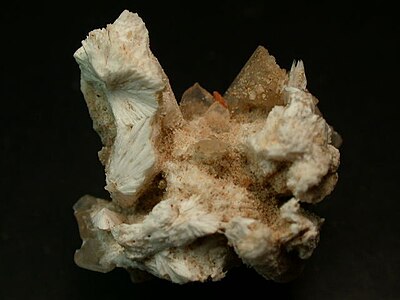Bassanite
| Bassanite | |
|---|---|
| White, radial-rayed bassanite crystals from Kimba, Eyre Peninsula , South Australia | |
| General and classification | |
| other names | |
| chemical formula | Ca [SO 4 ] · 0.5H 2 O |
|
Mineral class (and possibly department) |
Sulphates (selenates, tellurates, chromates, molybdates, tungstates) |
|
System no. to Strunz and to Dana |
7.CD.45 ( 8th edition : VI / C.22) 06/29/01/01 |
| Crystallographic Data | |
| Crystal system | monoclinic |
| Crystal class ; symbol | monoclinic sphenoid; 2 |
| Space group | I 2 (No. 5, position 3) |
| Lattice parameters |
a = 12.04 Å ; b = 6.93 Å; c = 12.67 Å β = 90.27 ° |
| Formula units | Z = 12 |
| Physical Properties | |
| Mohs hardness | not yet determined |
| Density (g / cm 3 ) | 2.69 to 2.76 |
| Cleavage | Please complete |
| colour | White |
| Line color | White |
| transparency | transparent to translucent |
| shine | Please complete |
| Crystal optics | |
| Refractive indices |
n α = 1.550 to 1.559 n β = 1.560 n γ = 1.577 to 1.584 |
| Optical character | biaxial positive |
| Axis angle | 2V = 10 to 15 ° |
Bassanite , not to be confused with the igneous rock basanite , is a rather rare mineral from the mineral class of " sulfates (including selenates, tellurates, chromates, molybdates, tungstates)" with the chemical composition Ca [SO 4 ] · 0.5 H 2 O. From a chemical point of view, the mineral is thus a water-containing calcium sulfate and, due to its water content, is also known as hemihydrate or hemihydrate .
Bassanite crystallizes in the monoclinic crystal system and develops predominantly massive mineral aggregates , rarely also needle-shaped, parallel aligned crystals and pseudo-hexagonal twins of white color up to 0.1 mm in length.
Etymology and history
Bassanite was first described in 1910 by the Italian mineralogist Ferruccio Zambonini (1880-1932), who named the mineral after the former professor of palaeontology Francesco Bassani (1853-1916) from the University of Naples .
classification
In the old (8th edition) and new systematics of the minerals according to Strunz (9th edition) , the bassanite belongs to the division of "water-containing sulfates without foreign anions ". The revised 9th edition, however, now divides this section more precisely according to the size of the cations involved and the mineral is accordingly in the sub-section “D. With only large cations ”.
The systematics of minerals according to Dana , which is common in the English-speaking world , assigns the bassanite to the division of " hydrated acids and sulfates with the general formula AXO 4 • x (H 2 O) "
Crystal structure
Bassanite crystallizes monoclinically in space group I 2 (space group no. 5, position 3) with the lattice parameters a = 12.04; b = 6.93; c = 12.67 and β = 90.27 ° and 12 formula units per unit cell .
Education and Locations

Bassanite is a conversion product of gypsum and is found in leucite or tephrite blocks either in the vicinity of fumaroles or in dried-out pond and lake basins.
So far, almost 40 locations for bassanite have been registered, mainly in the United States and Europe (as of 2009).
European sites include Ronneburg (Thuringia) in Germany; Dorset in Great Britain; Campania and Tuscany in Italy; Abtenau , Golling an der Salzach and Pöttsching in Austria; Katowice in Poland; Kamchatka in Russia; Canton Ticino in Switzerland; Banská Bystrica and Prešov in Slovakia; Bohemia and Moravia in the Czech Republic; the Crimean peninsula in Ukraine; and Fejér and Veszprém counties of Hungary.
American sites include La Paz County and Pima County in Arizona; Fresno Counties , Inyo Counties, and San Bernardino Counties in California; Franklin County , Massachusetts; Elko County in Nevada; Sussex County , New Jersey; Otero County , New Mexico; and Duchesne County , Utah.
Synthetic manufacture
Bassanite is made by heating plaster of paris . With further heating, bassanite eventually becomes anhydrite . The water of crystallization is not completely withdrawn from the bassanite (hemihydrate or hemihydrate), whereas anhydrite has no water of crystallization. When mixed with water, bassanite quickly hardens to plaster of paris, giving off heat.
See also: Chemical cooling
use
Bassanite is commercially available as an electrician's plaster.
See also
literature
- Friedrich Klockmann : Klockmann's textbook of mineralogy . Ed .: Paul Ramdohr , Hugo Strunz . 16th edition. Enke, Stuttgart 1978, ISBN 3-432-82986-8 , pp. 614 (first edition: 1891).
Web links
- Mineral Atlas: Bassanite (Wiki)
Individual evidence
- ↑ a b c d e f Bassanite . In: John W. Anthony, Richard A. Bideaux, Kenneth W. Bladh, Monte C. Nichols (Eds.): Handbook of Mineralogy, Mineralogical Society of America . 2001 (English, handbookofmineralogy.org [PDF; 66 kB ; accessed on June 15, 2018]).
- ↑ a b c American Mineralogist Crystal Structure Database - Bassanite (English, 2001)
- ↑ Centro Musei delle Scienze Naturali - Ferruccio Zambonini (Italian)
- ↑ Marco E. Ciriotti, Lorenza Fascio, Marco Pasero: Italian Type Minerals . 1st edition. Edizioni Plus - Università di Pisa, Pisa 2009, ISBN 978-88-8492-592-3 , p. 45 (English).
- ↑ a b Mindat - Bassanite (English)

